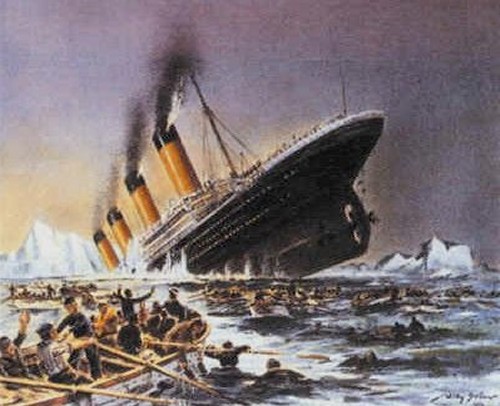 |
PART TWO -
Famous Maritime Disasters
Written by
Rick Archer
June 2012
The 1912
sinking of the Titanic one hundred years ago is
considered to be one of the most famous Disasters of
all time.
Why?
How does the Titanic disaster remain so most famous?
In our previous chapter,
we explored the world's most famous non-maritime disasters. In
this chapter, we will cover the maritime disasters.
|
|
WAR-RELATED CRUISE SHIP
DISASTERS -
WILHELM GUSTLOFF, CAP ARCONA, LUSITANIA
|
The sinkings of the
Lusitania, Cap Arcona, and Wilhelm Gustloff have little in common with
the Titanic. Like 9-11, these were all
acts of war.
The Wilhelm Gustloff was a German flagship that sank after
being torpedoed by a Soviet submarine in January 1945.
The Wilhelm Gustloff was struck while
participating in the evacuation of civilians, military
personnel, and Nazi officials who were surrounded by the Red
Army in East Prussia.
The Russians weren't particularly happy about this escape
effort. Ready Aim Fire. The Gustloff was hit by 3
torpedoes in the Baltic Sea on 30 January 1945.
It sank in less than 45 minutes. An estimated 9,400 people
were killed in the sinking, the largest known loss of life
occurring during a single ship sinking in recorded maritime
history.
However, since there wasn't much sympathy for the Nazis at
that point, most people just shrugged their shoulders and
muttered under their breath they got what they deserved.
The May 1945 sinking of the Cap Arcona four months later was
far more poignant. With 5,000 victims, the sinking of the
Cap Arcona ranks among the biggest maritime losses of life
in history.
The Cap Arcona was a large German luxury ocean liner that
transported passengers between Germany and South America
until 1940 when it was taken over by the German Navy.
Like the Wilhelm Gustloff, the Cap Arcona was used late in
the war for the evacuation of Germans from East Prussia. In
addition, the ship was heavily-laden with doomed Jews and
other prisoners from Nazi concentration camps. The ship was
sunk in 1945 by the Royal Air Force. Already imprisoned deep
within the ship, the pitiful Jewish prisoners never had a
chance. The ship sank far too quickly to help anyone.
The British fired on the vessel because they believed the
ship was full of SS officers trying to escape. Pilots of the
attacking force later stated that they were unaware that the
ships were laden with prisoners who had somehow survived the
camps this far.
These poor people were truly cursed. Sad to say, most of the
people who died in the sinking were scheduled to be put to
death one way or the other. One plan had them dying at a new
German extermination camp while another plan suggested a
German U-boat was preparing to sink the ship as the fastest
way to eliminate the prisoners. It looks like the RAF
unwittingly spared them the trouble. Whatever the truth, it
is a tragic story. Drowning is said to be a horrible way to
die although how anyone knows this is a mystery to me.
The Cap Arcona incident was not well-publicized at the time. I don't think England was keen
about having the story aired. In fact, I had never even
heard of the incident until a lecturer mentioned it on the
recent Titanic Memorial Cruise. Some people have suggested
the sinking of the Cap Arcona was England's revenge for the
Lusitania.
To the list, we must add the 1915 sinking of the Cunard
luxury liner Lusitania. After being struck by a German
torpedo, the Lusitania sank in 18 minutes. 1,200 out of
2,000 passengers died. The Lusitania was hardly a war
vessel. These were not only innocent victims, they were
totally helpless. The world's outrage was practically
identical to the rage people felt after 9-11. They
wanted revenge.
Germany's cheap shot would have repercussions. Germany paid a high price for their mindless behavior. The
sinking of the Lusitania led directly to America entering
World War I. "Remember the Lusitania" were the words that
spelled doom for Germany.
|
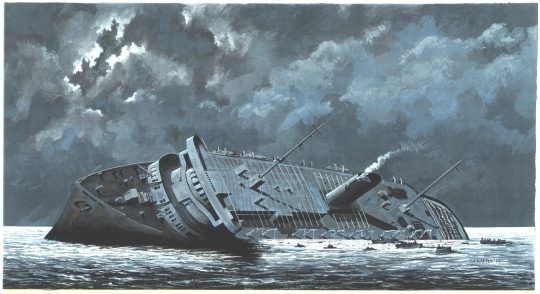
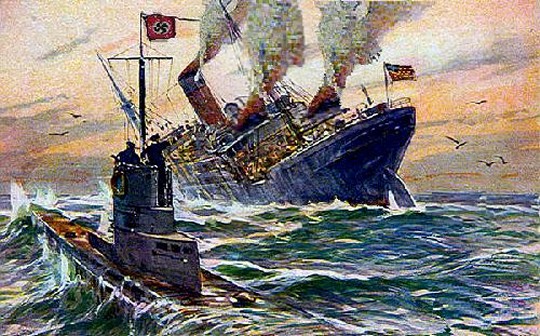
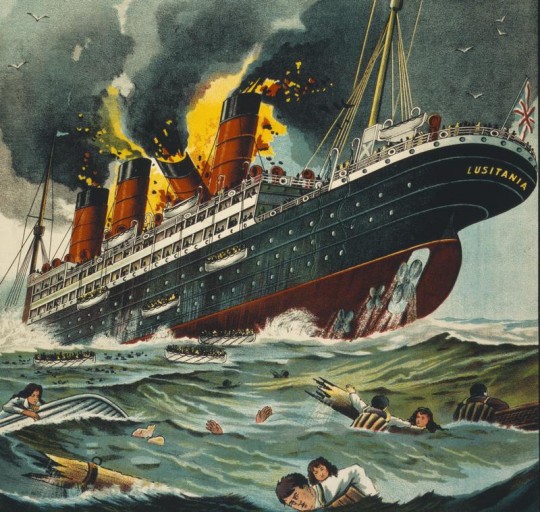 |
|
|
|
|
STUPIDITY-RELATED CRUISE SHIP
DISASTERS -
ANDREA DORIA and OCEANOS
|
The Titanic differs
completely from the disasters above. Human stupidity played the key role in the
Titanic disaster, not human evil.
Cruise ship disasters are not common, but they do seem to occur more
often than people suspect. When the investigation is over,
more often than not some person turns out to have been careless or
foolish.
Sad to say, even in our
modern times with radar and satellites, there are still seagoing
crashes.
For example, on December 20, 1987, the overcrowded
Philippine ferry boat, Dona Paz, collided with an oil tanker
off the island of Mindoro. The Dona Paz flipped over and
sank quickly. The accident took the lives of 4,536 passengers and crew.
Having survived a hijacking in 1985, the Italian cruise ship
Achille Lauro met its end on November 30, 1994.
The ship was sailing in the Indian Ocean off the coast of Somalia
with 1,000 passengers on board. It was close to the Horn of
Africa when a fire broke out on board in the engine room. The ship sank two days later.
Talk about a cursed ship!
The
Norwegian-owned cruise ship MS Estonia was en route from
Estonia to Stockholm, Denmark, on Sept. 28, 1994, when it
ran into severe weather in the Baltic Sea overnight and
rolled over. Of the nearly 1,000 people on board, 852 people
were killed.
Philippine-owned MV Princess of the Stars was sailing off
the coast of Sibuyan island, located in central Philippines.
Suddenly the 24,000 ton vessel was caught in the path of Typhoon Fengshen and capsized in rough seas on June 21, 2008. Of the
over 800 passengers and crew on board, only about 30 people
survived.
Let's face it - despite all precautions and new safety
features, the ocean is still dangerous. However on
closer inspection, it often turns out that human error at fault
more often than rough seas. I will now tell the story of three modern day
cruise ship disasters that are darkly
reminiscent of the Titanic story. As you will read,
human error played a key role in each story.
The tale of the Andrea Doria is a perfect example of human
stupidity causing a major maritime disaster. The Andrea
Doria was an enormous Italian cruise liner that sunk in a
collision with a Swedish ship named the Stockholm. The
accident took placein 1956 just
outside the New York harbor. The main culprit
was fog. The other culprit was the heavy traffic outside the
NY harbor. On paper, the accident didn't make much sense.
After all, the Andrea Doria and the Stockholm were
equipped with radar. This collision should never have
happened. But it did.
Both ships knew the other ship was in the area, but they
couldn't "see" with their own eyes. At the last moment, the
helmsman aboard the Stockholm was stunned to see the Andrea
Doria appear out of nowhere in the fog. Forced to make a
snap decision, he panicked and made a horrible mistake. He
turned his ship head on to aim straight at the Andrea Doria.
By the time he realized his mistake, it was too late.
The
Stockholm rammed the front of the Andrea Doria broadside,
creating a huge gash. Struck in the side, the top-heavy
Andrea Doria immediately started to list severely to
starboard. There was no doubt this ship was doomed. The
luxury liner soon capsized. It sank beneath seas the following morning.
46 people died in the collision.
Fortunately, the rescue effort went smoothly and there were
no further casualties. The crew did its job well taking care of the passengers. 1,660 passengers
and crew survived.
Although the crew performed brilliantly on the Andrea Doria,
we all know this is not something we can take for granted. The
story of the Oceanos will demonstrate this point conclusively.
The MTS Oceanos was a Greek-owned cruise ship
that sank off South Africa's eastern coast.
On 3 August 1991, the Oceanos set out from East London,
South Africa, headed to Durban, South Africa.
The ship headed into 40-knot winds
and 30 foot swells. Usually there would have been a
"sail-away" party on deck with musicians and entertainers.
However, due to the rough sea conditions, this event was
held inside at the lounge. They probably should
have just cancelled. Most passengers chose to stay in
their cabins because the rough seas were making everyone miserable.
The ship continued nevertheless.
The storm worsened as the evening progressed. When the first
seating of dinner was served, the waiters could hardly carry
the trays of food without dropping something. The
ship was rolling about from side to side so badly that
crockery and cutlery began sliding off the tables and potted
plants all over the ship were toppling.
At 9:30 pm, a muffled explosion was heard. The Oceanos lost
her power following a leak in the engine room's sea chest.
Water was entering the hull and flooding the generator room.
The generators were shut down because the rising water would
have short circuited them. The ship was left floating adrift
in the rough seas without power.
The water level in the ship steadily rose. It flowed through a 4 inch hole in
the bulkhead and into the sewage waste disposal tank.
Without check valves in the holding tank, the water coursed
through the main drainage pipes and rose through the ship,
spilling out of showers, toilets, and waste disposal units.
Can you imagine?
Realizing the fate of the ship, the crew down below fled
upstairs in panic. They neglected to close the lower deck
portholes, which is standard policy during emergencies.
Incredibly, no
alarm was raised. Passengers remained ignorant of the events
taking place below until they witnessed the first signs of
flooding in the lower decks themselves. Imagine the panic
thanks to the lack of warning.
At this stage, eyewitness accounts reveal that many of the
crew, including Captain Avranas, were already packed up and
ready to depart. The captain quickly got his family into a
boat and joined them. The crew was seemingly unconcerned with the
safety of the passengers.
Nearby vessels responded to the ship's SOS and were the
first to provide assistance. The South African Navy along
with the South African Air Force launched a seven-hour
mission in which 16 helicopters were used to airlift the
passengers and crew to safety.
All 571 people on board were saved thanks to a hero who
emerged from nowhere. Moss Hills, hired on as
a singer, is the man who organized the orderly evacuation of
passengers by the helicopters.
The following day, the Oceanos rolled over onto her side and
her stern rose upright and sank.
Here is a quote from one of the people rescued: "Moss Hill
was one of the heroes from the Oceanos. In fact Moss was the
person that put the harness over me. He personally
saw to it that I was air lifted to safety from the Oceanos.
Without Moss I would not be here today to tell the story. So
many of us owe him our lives for being there to orchestrate
the rescue operation."
One of the last five people off the ship, Hills was
acknowledged as the only person from the ship's
crew who stayed behind to help. Later on, Hills was quite
modest about it. He pointed to his wife Tracy and said she
deserved just as much credit as he did.
What an absurd story! You and I would laugh our heads off if we saw a made-for-TV
movie where the crew fled and all the passengers were saved by the singers!
Except in this case, that's exactly what happened. You find heroes
in the most unlikely places.
The
Captain of the Oceanos, Yiannis Avranas, was accused by the passengers of
leaving hundreds behind with no one other than the ship's
onboard entertainers to help them evacuate. Avranas claimed
that he left the ship first so he could better arrange for a rescue effort.
He said he personally supervised the rescue from a helicopter.
Captain Avranas stated, "When I give the order to abandon
ship, it doesn't matter what time I leave. Abandon is for
everybody. If some people want to stay, they can stay."
The story of the Oceanus is not well-known since no lives
were lost at sea… no thanks to the despicable Captain of
course.
The question is, what was he doing taking his ship into such rough
waters in the first place?
By the way, does the
behavior of the Captain of the Oceanos remind you of someone else?
Yeah. What's his name… uh… yeah,
the Captain of the Costa Concordia!!
|
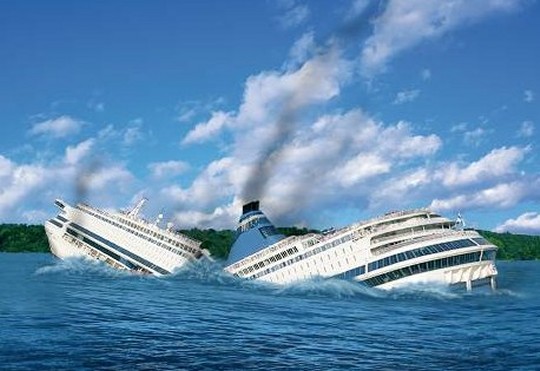
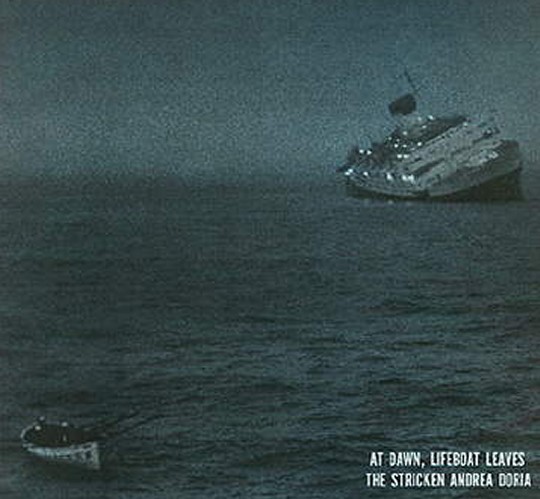
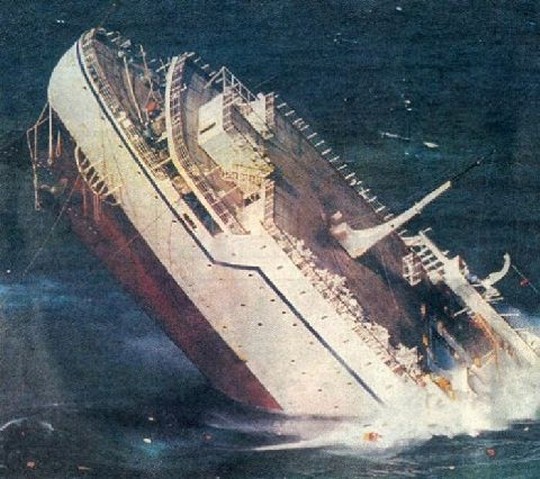
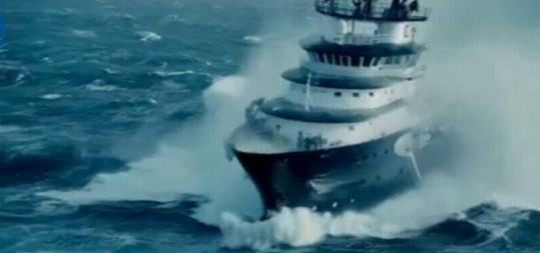
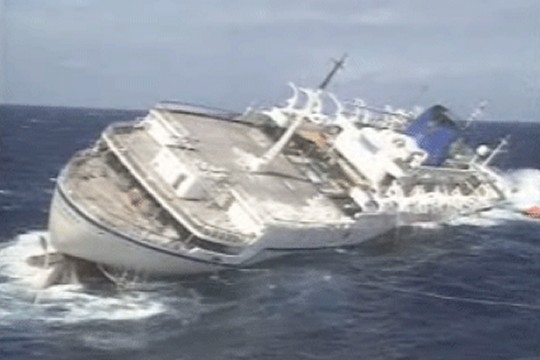
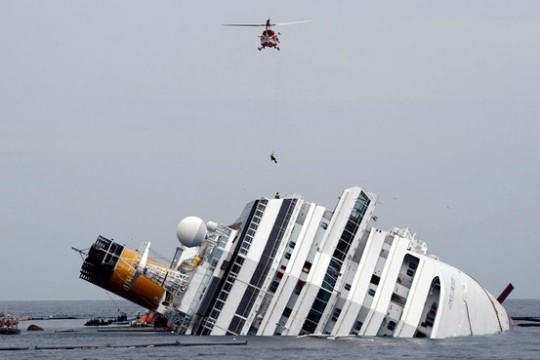
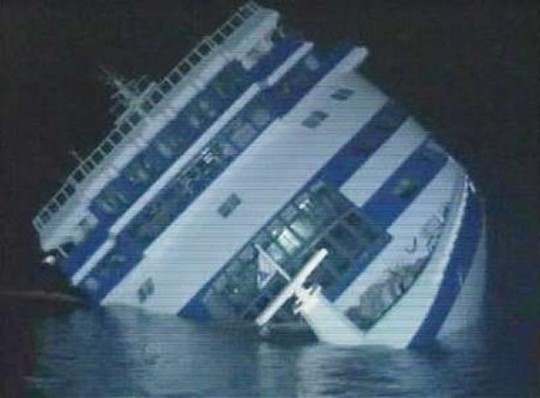 |
COSTA CONCORDIA
|
Who can overlook the crazy parallels between the 2012 Costa Concordia sinking and the story of the Titanic?
In the
case of Costa Concordia, it is ridiculous to think a modern
cruise ship could be crippled so effortlessly. A glancing
blow to the side of the ship by an underwater rock was all
it took to sink this ship despite the latest in modern
safety features. Somewhere in the deep, the ghosts of the
Titanic surely stirred. This kill-shot gash in the side of
the ship was eerily reminiscent of their own ship's demise.
Afterwards Captain Schettino of the Concordia claimed the
accident wasn't his fault. It was surely an act of God. He
claimed his ship had struck an underwater rock that wasn't
on the map.
"Oh mio dio, questo è terribile!" Omigod, what a
tough break!!
However, what was the Captain doing deliberately taking the
ship so close to shore in the first place? Study the
picture of the ship's route.
Testimony from members of the crew indicated the captain had
caused the disaster by veering the ship too close to shore
where it hit a rock. They added the damning suggestion
that Schettino had done so in a bravura "salute" to residents of
Giglio, a Tuscan island off Italy's coast.
Just to give you an idea how poorly Schettino behaved that
night, let me share the famous exchange Schettino had with
Italian Coast Guard commander Gregorio de Falco during the
frantic moments after the accident. If you have never read
this before, you better brace yourself.
De Falco:
This is De Falco of the Coast Guard speaking from Livorno. Am I
speaking with the commander?
Schettino:
Yes. Good evening, Commander De Falco.
De Falco: Please tell me your name.
Schettino:
I'm Commander Schettino, commander.
De Falco: Schettino? Listen Schettino.
I understand that you are not presently on the ship. There are people
trapped on board. Now you go with your boat under the prow
on the starboard side. There is a pilot ladder. You will
climb that ladder and go on board. You go on board and then
you will tell me how many people there are. Is that clear?
I'm recording this conversation, Cmdr Schettino ...
Schettino:
Commander, let me tell you one thing ...
De Falco: Speak up! Put your hand in front of the microphone
and speak more loudly, is that clear?
Schettino:
In this moment, the boat is tipping ...
De Falco: I understand that, listen, there are people that
are coming down the pilot ladder of the prow. You go up that
pilot ladder, get on that ship and tell me how many people
are still on board. And what they need. Is that clear? You
need to tell me if there are children, women or people in
need of assistance. And tell me the exact number of each of
these categories. Is that clear? Listen Schettino, that you
saved yourself from the sea, but I am going to ... really do
something bad to you ... I am going to make you pay for
this. Go on board! (expletive)!
(At this
point, De Falco lost his temper. De Falco grew so angry at
Schettino's stalling that he screamed, "Vada a bordo, cazzo!"
which can be translated as "Get the fuck back on board the
ship!"
Schettino:
Commander, please ...
De Falco: No, please. You now get up and go on board. They
are telling me that on board there are still ...
Schettino:
I am here with the rescue boats, I am here, I am
not going anywhere, I am here ...
De Falco:
(screaming) What are you doing, commander?
Schettino:
I am here to co-ordinate the rescue ...
De Falco: What are you coordinating there? Go on board!
Coordinate the rescue from aboard the ship! Are you
refusing?
Schettino:
No, I am not refusing.
De Falco: Are you refusing to go aboard, commander? Can you
tell me the reason why you are not going?
Schettino:
I am not going because the other lifeboat is
stopped.
De Falco: You will go aboard. It is an order. Don't make any
more excuses! You have declared "abandon ship". Now I am in
charge. You go on board! Is that clear? Do you hear me? Go,
and call me when you are aboard. My air rescue crew is
there.
Schettino:
Where are your rescuers?
De Falco: My air rescue is on the prow. Go. There are
already bodies in the water, Schettino.
Schettino:
How many bodies are there?
De Falco: I don't know. I have heard of one.
My God, you are
the one who has to tell me how many there are! Christ!
Schettino:
But do you realize it is dark and here we can't
see anything!
De Falco: And so what? You want to go home, Schettino? It is
dark and you want to go home? Get on that prow of the boat
using the pilot ladder and tell me what can be done, how
many people there are and what their needs are. Now!
Schettino:
... I am with my second in command.
De Falco: So both of you go up then ... You and your second
go on board now. Is that clear?
Schettino:
Commander, I want to go on board, but it is
simply that the other boat here … there are other rescuers.
It has stopped and is waiting ...
De Falco: It has been an hour that you have been telling me
the same thing. Now, go on board. Go on board! And then tell
me immediately how many people there are there.
Schettino:
OK, commander.
De Falco: Go, immediately!
That is a truly remarkable
exchange. As the world around the world read the transcript,
they shook their head in genuine disgust.
Schettino was later dubbed "Captain Coward" by the press.
For the record, like
Schettino, Captain Smith of the
Titanic made made serious errors in judgment as well, but he was certainly no coward. Smith
never abandoned the Titanic. Captain Smith stayed aboard the ship
awaiting his certain fate right up to the bitter end.
The same could not be
said of Captain Schettino.
|
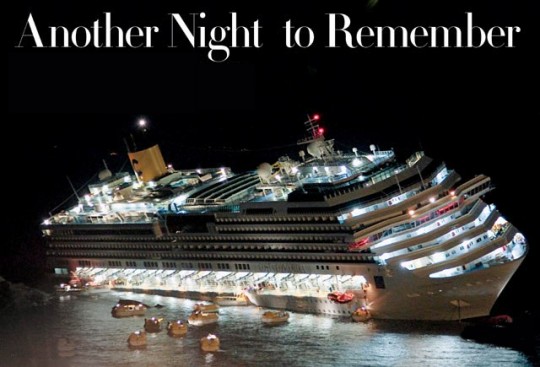
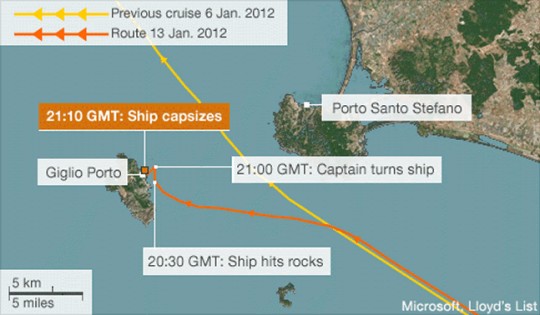


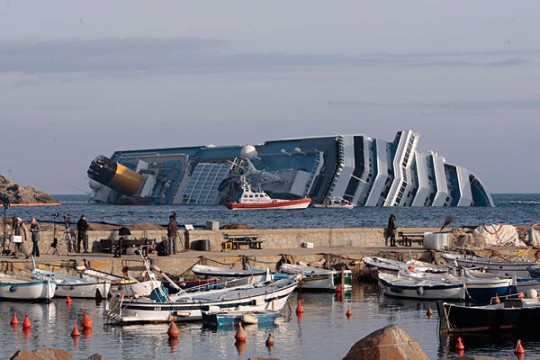
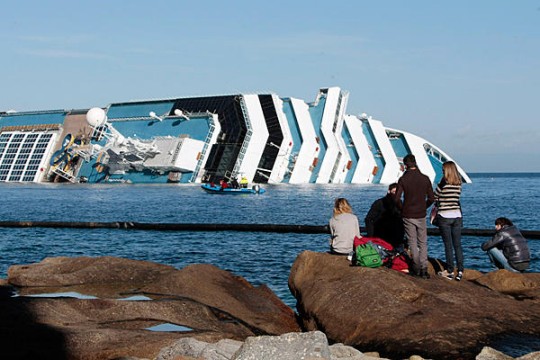
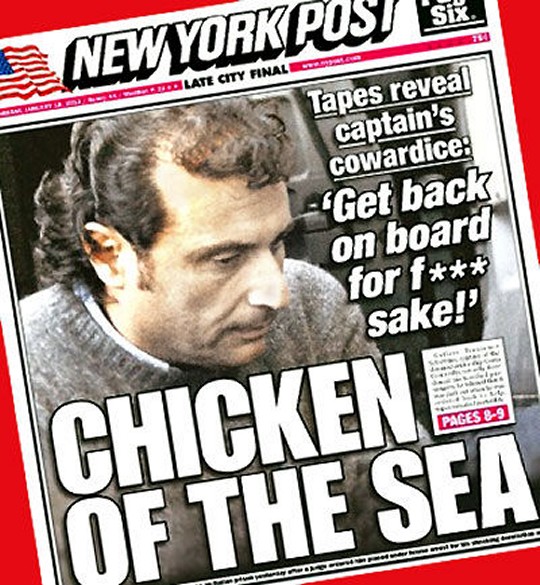 |
|
COLOSSAL
ARROGANCE
The stories of the Titanic, the Oceanus,
the Costa Concordia and the Andrea Doria demonstrate that people in command sometimes
show judgment that is so poor the rest of us just gape in
open-mouthed shock.
However, in all these
stories, the behavior of Schettino on the Costa Concordia absolutely
takes the cake. This man was wrong on so many different levels
it staggers the imagination.
For starters, what is
the number one cause of serious car accidents after alcohol?
Take a quick guess. The answer, of course, is texting or
talking on a cell phone while driving. It results in loss of
concentration and it requires the driver to take his eye off the
road. Both errors lead to serious accidents.
|
 |
Schettino will go down in
history as the first captain to ever wreck a cruise liner because he
was on the phone. In fact, he actually used the phone as one
of his excuses. In an interview with the Italian TV channel
Canale 5 on 10 July 2012, Schettino stated that the distraction by
this telephone call had been a contributing factor to the accident.
Can you imagine the
nerve of using the telephone as an excuse for killing 32 people?
Any ordinary human being would prostrate themselves on the floor and
beg for forgiveness through weeping tears. Schettino is no
ordinary human being. You have to wonder how on earth this man
achieved a position of such great responsibility.
And who, exactly, was
Schettino talking to?
According to Wikipedia,
at the time of impact, Captain Schettino was on the telephone with
retired Captain Mario Palombo, a buddy of his. Palombo lived
on the isle of Giglio.
Schettino was busy
telling Palombo, "Seeing as we're passing your island soon, we'll
sound the siren for you."
In addition, at the
captain's invitation, the maître d'hôtel of the ship, who is from
the same island, came to the ship's bridge to view the island during the
sail-past. Furthermore, Schettino's mistress was said to be up
there too. Let's have a party!
It is safe to say Schettino was not paying very
good attention that day.
Modern ships have all
sorts of safety equipment. The only thing modern ships do not
have are "stupidity detectors".
Costa Cruises later
confirmed that the course taken was "not a defined, computer
programmed route for passing Giglio."
So what does that mean? Costa Cruises CEO Pier Luigi Foschi explained that the company's ships have computer-programmed
routes. There are "alarms that go off if the ship deviates by
any reason from the stated route as stored in the computer and as
controlled by the GPS".
So why didn't any alarms
go off?
Foschi admitted that these alarms
could be "manually" overridden.
And who do you suppose turned
them off?
Captain Schettino stated
that, before approaching the island, he had turned off the alarm
system for the ship's computer navigation system. "I was navigating
by sight, because I knew those seabeds well. I had done the move
three, four times."
Schettino obviously
didn't know the seabeds that well. Some nasty, uncharted rock
beneath the waves was waiting for him. Distracted, Schettino
did not notice waves breaking on the unseen reef until it was too
late to take appropriate action.
Schettino told investigators
that he looked up, saw waves breaking on the reef and turned abruptly.
This swung
the side of the hull into the reef. In other words, Schettino
over-reacted to the danger because he wasn't paying attention
and inadvertently made the ship even more vulnerable.
"I have to take
responsibility for the fact that I made a judgment error."
No kidding.
The captain had
initially stated that the ship had been about 300 metres (980 ft)
from the shore (about the length of the vessel) when it hit an
uncharted rock. Next, Schettino blamed the maps
for his mistake.
"That rock was not on
the chart!"
With such serious errors
in judgment, the entire world naturally assumed
that surely Schettino had been drinking or was on some sort of drugs.
Surprisingly, Schettino passed a drug
test. On 19 February 2012, the Associated Press reported that
traces of cocaine had been found on Schettino's hair samples "but
not within the hair strands or in his urine — which would have
indicated he had used the drug".
In other words,
Schettino had not used cocaine himself, but had likely been in close
contact with someone who had.
As investigators dug
deeper, they discovered Schettino had smuggled a mistress on board.
Domnica
Cemortan, 25, reportedly did not appear on any official manifest for
the Costa Concordia. A former dancer and crew member, Cemortan
later told Italian investigators that she was on the bridge as a
"guest" of the captain at the time of the crash.
|
 |
While Ms Cemortan was not
accused of any offense, her testimony played a key role in
establishing exactly what happened on the bridge that night and
whether the captain was distracted.
While drugs did not
contribute to the accident, there is a strong possibility alcohol
was involved. Based on reports from
several passengers, just minutes before Costa Concordia cruise ship
accident at around 9.40pm on 13 January, Captain Francesco Schettino
was having an intimate dinner with a blonde and young girl.
They were sharing some wine.
One passenger claimed
that he saw the captain having dinner with an unidentified slim
blonde woman and another officer shortly before the vessel hit the
rocks. They were both drinking from a decanter of red wine in
the ship's best restaurant
Angelo Fabbri, from Savona, said that he and his wife saw Captain
Schettino in the Concordia Club restaurant at 9:05 pm on the evening
of the accident. A menu was served for special guests: prawn
cocktails, pasta with shrimps and a fish grill.
"Schettino, in a dark suit, was sitting in front of the woman. She
seemed young. At first, we thought it was his daughter. A pretty
woman, 25 or 30 years old, slim, with shoulder-length blonde hair,
with a black dress with open arms," he told Il Secolo XIX newspaper
in Genoa.
"They were laughing. There was trust between them, great happiness.
There is no doubt they were drinking, at least a whole decanter. The
last drop was poured into the captain's glass."
"They left the table crossing the room single file, walking between
the tables: first Schettino, then the woman and finally the third
diner."
|
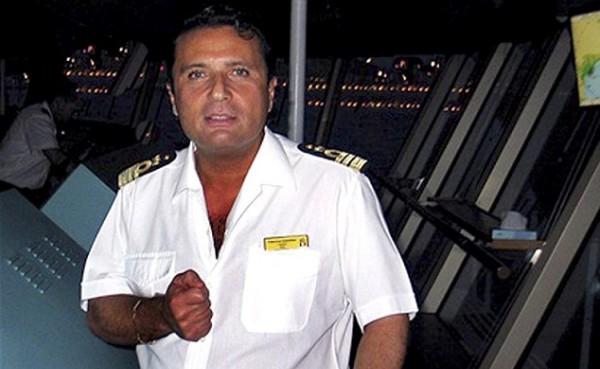 |
Following the tragic
accident, Miss Cemortan was one of the first off the ship. The
critics had a field day, saying her quick getaway helped to
establish what Schettino's priorities were on that tragic night.
In an interview with a
Moldovan TV station, the 25-year-old mother of two admitted that she
was falling for the captain despite the fact that he had his wife and a teenage daughter
back home. Cemortan stated, “I love him! It's not right to
destroy his reputation!”
She added, “I was on the
bridge because I was in love with the captain. I found him charming
and fascinating. I love him!"
Despite the fact that Captain Schettino was one of the first to be
off the ship, Cemortan insisted, “Captain Coward' is actually a
hero. He did a great thing, he saved over 3000 lives!”
There you go. Talk
about Stand by your Man! This is definitely a 'let's look on
the bright side' kind of girl. In the eyes of his mistress,
Schettino was remarkable for his heroic efforts to save everyone
from his safe location on shore.
Italian media reported that Cemortan did not have a cabin.
Apparently divers entered Schettino's cabin after the accident and
discovered some of Cemortan's clothing and belongings. Finally the mystery of where the love-starved stowaway had been
sleeping was solved.
One would assume that
having killed 32 people, injured 64 others, destroyed a $650 million
cruise ship, and created a gigantic environmental threat, Schettino would show at least some sense of remorse and
responsibility.
Not this guy.
Schettino was prepared to shock the world again.
In October 2012, eight
months after the accident, the disgraced captain of the Costa
Concordia filed suit against Costa Cruise Lines for wrongful
dismissal.
This was preposterous! One paper quipped that
Schettino had accomplished the impossible. All of Italy was quiet for an entire minute
at the news. The utter audacity of the action had apparently
left the entire country speechless with outrage.
|
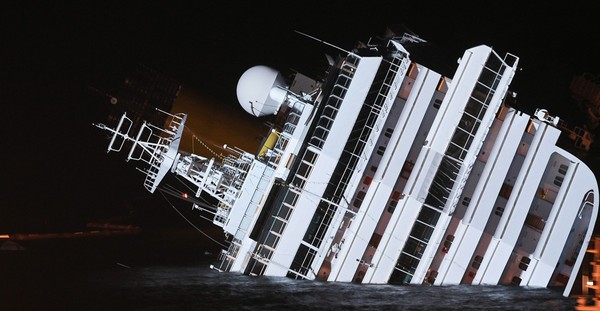 |
The outrage wasn't hard
to understand. After all, this is a captain who interrupted dinner
with his mistress only long enough to run his ship into the rocks, kill 32 of his crew and guests and then hop into a lifeboat
at the first opportunity to leave the carnage he caused behind.
Defying the tradition
that called for the Captain to be the last off the ship, no one had
ever heard of a Captain being the first off the ship before.
And now he was upset that they fired him. "I wasn't my
fault!!"
Eventually everyone got their voices back. Someone wrote they
hoped he would be found "guilty of arrogance in the first degree."
One lawyer suggested
Schettino could follow up with a "slip and fall" lawsuit. "I
hurt my back while I was trying to escape!"
Another questioned why Schettino didn't ask for a commendation based
on "rapid abandonment of a ship beyond the call of duty".
My favorite was:
"Captain Coward didn't like his nickname, so he changed it to
Captain Chutzpah."
Clearly the all-time
poster boy for outright gall is our forlorn Captain Schettino.
I
think this man has set the standard for "arrogance" so high that the
world may end before anyone ever tops this guy.
|
|
|
|
|